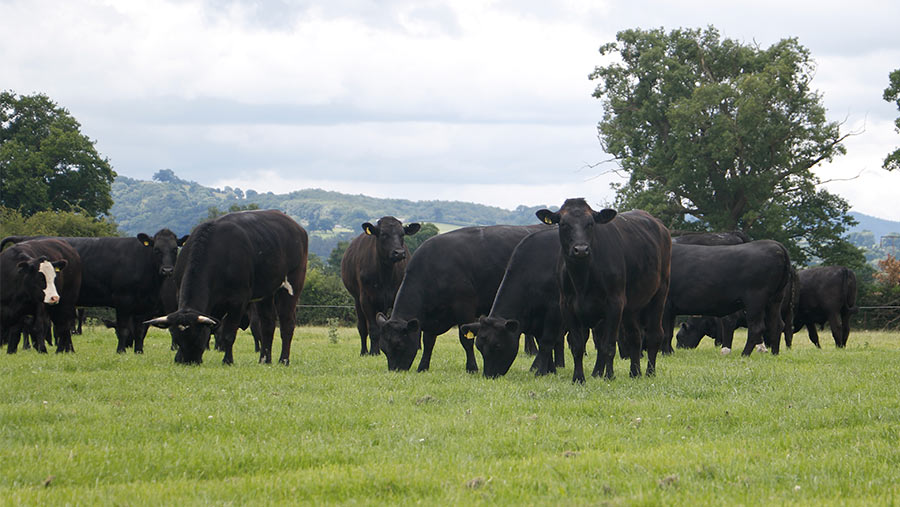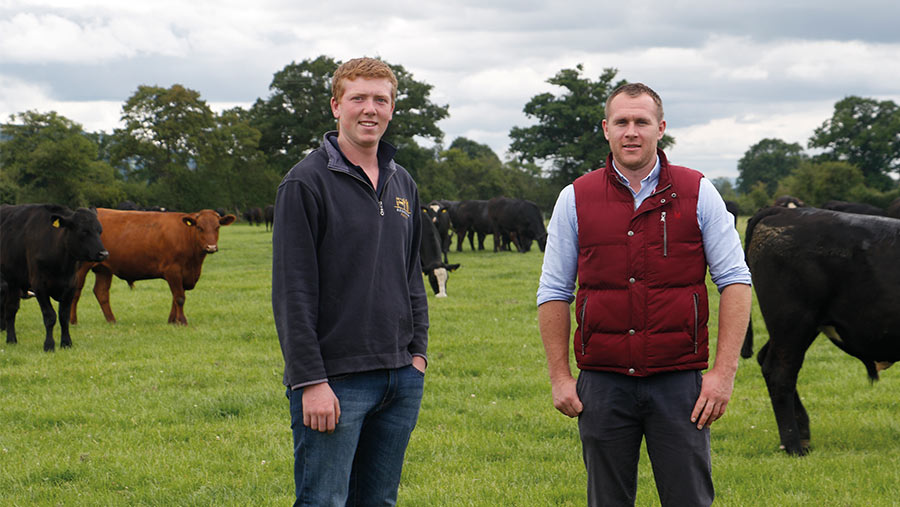How beef processor Pickstock improved output by £560/ha
 © Rhian Price
© Rhian Price Beef processor Pickstock Telford has lifted output by £560/ha/year since switching to rotational grazing.
The processor finishes 700 dairy-bred beef calves annually at its state-of-the-art beef finishing facility, Brongain Farm in Llanfechain, which has always been semi-extensive, set stocking cattle at grass during the summer months.
But to meet its ambition of becoming carbon neutral by 2030 and improve business sustainability, Brongain Farm has invested in a rotational grazing platform and is making a concerted effort to make better quality forage to form the basis of cattle diets.
See also: 4 key pointers from a beef grazing trial
Farm facts
- Farming 263ha (680 acres)
- Finishing 700 dairy cross beef cattle annually
- Cattle sold at 630-650kg (330kg deadweight) to Pickstock at 22-23 months, achieving O+ classification and above and fat class 3-4L
The farm is making the most of home-grown protein and forage which will enable it to reduce reliance on imported feeds, and it says better soil and land management will help increase carbon sequestration from the atmosphere.
Rowan Pickstock, who manages the unit and is the third generation of the family to work in the business, says there is increasing demand from retailers to improve their environmental sustainability.
With the Better Grazing project now in its second season, we visited the family’s farm to find out what strides they have made.
Grazing platform
The grazing platform is part of Brongain Farm and comprises 86ha (211 acres).
Mr Pickstock says utilising grass in the diet complements the native Angus cross calves bought in from local dairy farms for finishing.
“The Angus can lay down too much fat if they are pushed too hard,” he explains.
About 36ha (90 acres) has already been reseeded with long-term leys of perennial ryegrass and clover, with tracks currently being installed to make moving cattle easier.
The platform is on a floodplain so in the future they would like to use diverse swards containing chicory, plantain and fescues to improve root mass and aid water infiltration. These diverse swards can not only help increase yields during dry periods, but also aid carbon capture.
To keep things simple and make it easier to take paddocks out of the rotation for silage, semi-permanent electric fencing has been used to sub-divide 4-6ha (10-15 acre) fields in two.
Cattle are grazed in three mobs, with each mob grouped by weight. This includes one group of 80 animals weighing 290kg, 94 cattle weighing 460kg and 99 weighing 557kg, on average.
Cattle are weighed every six weeks using a mobile handling system and weigh scales. The three groups are averaging 1kg daily liveweight gain (DLWG) since turnout.
More recently, a third group of 70 younger animals – weighing 220kg – has been introduced to the platform to help balance out supply and demand, with grass growth accelerating in recent weeks.
The farm’s nutritionist, Iwan Vaughan of Dairy Diagnostics, explains: “The rumen is well developed by six months so you can put calves out to grass without concentrate.
“We aim to get the calves on to a forage-based diet as soon possible to condition and develop the rumen. This allows the calves to be turned out to grass earlier and concentrates can be reduced from the diet at five to six months of age.”
Silage-making
Cattle are housed for six months of the year on average, so the focus is to make the best-quality silage possible to cheapen the winter ration.
Traditionally the farm made two cuts, but is adopting the dairy industry’s mentality by starting earlier in the season, in May, and taking subsequent cuts from the 122ha (300 acre) silage platform every five weeks.
Digestate is applied pre-harvest from Pickstock’s anaerobic digester in Telford. After every cut nitrogen fertiliser is applied. So far this season, 62kg/ha of nitrogen has been spread.
Mowing and raking are done in house and a local contractor is used to chop and ensile the crop.

Rowan Pickstock (left) and Iwan Vaughan © Rhian Price
One of the biggest changes has been reducing wilt times to 24-36 hours to preserve quality.
“The forage isn’t a carrier for concentrate. It’s the main part of the diet,” says Mr Vaughan.
Previously the aim was for 10ME silage, but the target is now above 11ME at 15-16% protein and 30%-plus dry matter.
Providing silage is good enough, animals will be fed just forage. Only animals three months off finishing are supplemented with 2-3kg of barley, bought locally.
Future
Output has lifted 41% from £774/ha to £1,332 as growth rates have risen 0.2kg a head a day and stocking rates have increased (see table).
In the long term, Mr Pickstock hopes rotational grazing will further improve business efficiency by reducing purchased feed costs and allowing stock throughput to increase.
Farmers Weekly will return to Brongain to find out how they are progressing next season.
Increased output |
||||||
|
|
Number of cattle on grazing platform
|
Daily liveweight gain |
Total output (growth rate x number of cattle) |
Output/ha/day (total divided by 86ha) |
Output of beef/ha/day |
Total output/ha/year (for six-month grazing period) |
|
Under set stocked system |
250 |
0.8kg |
200kg |
2.32kg |
£4.30 |
£774 |
|
Under rotational grazing system |
343 |
1kg |
343kg |
4kg |
£7.40 |
£1,332 |
|
Increase |
93 |
0.2kg |
143kg |
1.68kg |
£3.10 |
£558 |
| Beef was valued at £1.85/kg of liveweight. Output/ha/day was multiplied by 180 (days in the grazing season) to get total output/ha/year | ||||||
Stages of the beef finishing enterprise
- Angus cross calves are sourced from high-health dairy farms at two weeks old.
- Calves receive milk replacer through automatic feeders alongside ad-lib straw and nuts.
- Weaned off milk at 10 weeks and at 16 weeks they transition on to a home-grown forage diet.
- Weaned calf diet includes silage, blend and straw alongside (forage inclusion increases from 25% to 75%) to adapt the rumen.
- By five to six months the rumen is fully developed and cattle are turned out to grass.
- Cattle are typically outside from March to October/November.
- In the autumn/winter when cattle are housed only those three months off finishing will be supplemented with barley.
